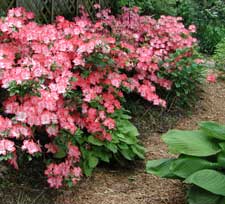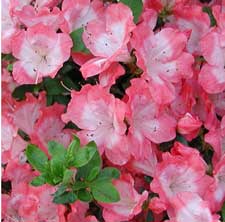Resource Library
Plant of the Week: Margaret Douglas Azalea
The University of Arkansas System Division of Agriculture does not promote, support or recommend plants featured in "Plant of the Week." Please consult your local Extension office for plants suitable for your region.
Plant of the Week
Margaret Douglas Azalea
Latin: Rhododendron Margaret Douglas Morrison’s Back Acre Azalea

For more than 10 years, my favorite azalea has grown in my garden like an unloved orphan, for it had no name. Twice I’ve happened upon named versions of what I thought was the same plant, but in both cases the names were wrong.
Finally, a few weeks ago, I was able to give it a name after a few hours prowling the Internet. It’s Margaret Douglas, one of the Back Acre hybrids developed by Ben Morrison.
Margaret Douglas is an evergreen azalea growing 4 feet tall in 10 years. If given plenty of room, it’ll grow wider than tall. The single, 3-inch wide, two-toned flowers are soft pink on the inside with a broad picotee band of coral on the outside.
They appear late in the azalea season, for me usually during the first week of May about the time blooms on mid-season azaleas have turned brown.
Margaret Douglas was developed by Ben Morrison (1891-1966), one of the stalwarts of American horticulture during the middle years of the 20th century. During 1964 and 1965, Morrison registered and released 53 azalea hybrids from his garden in Pass Christian, Mississippi, calling them the Back Acre Hybrids.
Morrison began his azalea breeding career in 1929 as part of his work for the Plant Introduction Station in Glenn Dale, Md. This USDA-run facility was a receiving station for material plant explorers brought back from their trips. His breeding goal was to develop large flowered, but winter hardy, azaleas such as seen in the milder parts of the southeastern states. Starting with the large flowered, but winter-tender Rhododendron indicum, he made crosses with more hardy species and cultivars. Between 1947 and 1949, he released 440 “Glenn Dale azaleas” onto the nursery scene.
It was the release of all these azaleas that caused him to step down as Director of Plant Introduction. When he introduced the azaleas he was asked by a private collector for rooted cuttings of all of his Glenn Dale hybrids. He turned this person down so the individual approached their congressman who asked Morrison to send on the plants.

When Morrison turned down the congressman, Morrison’s bosses at the USDA got involved and ordered him to send the plants. This prompted his resignation from the Glenn Dale station and his subsequent work as the first full-time director of the U.S. National Arboretum. In 1951, he retired from the USDA completely and headed south to Mississippi, taking with him 124 flats of azalea seedlings (about 6,000 plants).
Margaret Douglas is a three-way hybrid using R. indicum for its large flower size. For winter hardiness, it was crossed with Hatsushima, a hardy form Morrison had acquired in the late 1920s from Kent Beattie, a plant pathologist sent to the Orient to look for chestnuts resistant to the blight that had been killing trees throughout the eastern states.
In the spring of 1948, the product of this initial hybrid was crossed with a 1939 Satsuki azalea introduction called Shinsei that Morrison had acquired directly from a Japanese nursery. It provided the beautiful picotee flower pattern and the late blooming characteristic. It’s unclear whom the cultivar name commemorates.
The Back Acre hybrids, including Margaret Douglas, are winter hardy as far north as Zone 7. Like all azaleas, they’re best grown in bright areas with either high shade or some shade during the afternoon hours. Unless your garden is blessed with sandy, acidic soil, plant them in raised beds composed of aged pine bark. Adding 10-15 percent sand (on a volume basis) will improve the water holding characteristics of the pine bark. If the growing medium has a pH between 5 and 5.5, good drainage is provided and plants are watered before drought becomes extreme, azaleas are relatively easy to grow.
Planting them directly into a heavy clay soil almost always results in dead plants. Scout for azalea lacebug around the date of the last frost and take action if a significant population is noticed.
By: Gerald Klingaman, retired
Extension Horticulturist - Ornamentals
Extension News - May 25, 2007
The University of Arkansas System Division of Agriculture does not maintain lists of retail outlets where these plants can be purchased. Please check your local nursery or other retail outlets to ask about the availability of these plants for your growing area.